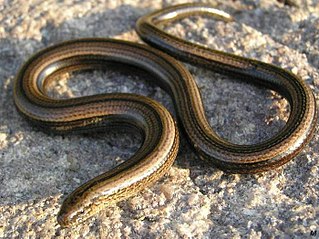This page is based on this
Wikipedia article Text is available under the
CC BY-SA 4.0 license; additional terms may apply.
Images, videos and audio are available under their respective licenses.

Gekkonidae is the largest family of geckos, containing over 950 described species in 61 genera. Many "typical" geckos are members of Gekkonidae, including house geckos (Hemidactylus), tokay geckos, and day geckos (Phelsuma). Gekkonid geckos occur globally and are particularly species-rich in tropical areas.

Afrogecko is a genus of small leaf-toed geckos, lizards in the family Gekkonidae. The genus is endemic to southern Africa. The genus was revised in 2014 by Heinicke et al.

Hoplodactylus is a genus of gecko endemic to New Zealand, one of the seven genera of geckos found only in New Zealand. Hoplodactylus comprises two species of large to gigantic brownish lizards, one extinct and one surviving only on predator-free islands.

Legless lizard may refer to any of several groups of lizards that have independently lost limbs or reduced them to the point of being of no use in locomotion. It is the common name for the family Pygopodidae, but often refers to other groups, such as limbless anguids, depending on the region of the world. These lizards are often distinguishable from snakes on the basis of one or more of the following characteristics: possessing eyelids, possessing external ear openings, lack of broad belly scales, notched rather than forked tongue, having two, more-or-less equal, lungs and/or having a very long tail.

The Diplodactylidae are a family in the suborder Gekkota (geckos), with about 137 species in 25 genera.
These geckos occur in Australia, New Zealand, and New Caledonia. Three diplodactylid genera have recently been split into multiple new genera
Amalosia obscura, also known as the slim velvet gecko is a gecko endemic to western Australia.
The reticulated velvet gecko is a species of geckos endemic to Australia.
Oedura cincta, sometimes called the inland marbled velvet gecko, is a gecko endemic to Australia.
Oedura coggeri, commonly known as the northern spotted velvet gecko, is a species of gecko, a lizard in the family Diplodactylidae. The species is endemic to Queensland, Australia.
The fringe-toed velvet gecko is a gecko endemic to Australia.
Oedura gemmata, also called the jewelled velvet gecko or dotted velvet gecko, is a gecko endemic to Australia.
The gracilis velvet gecko is a gecko endemic to Australia.
The Quinkan velvet gecko is a gecko endemic to Australia.
Oedura luritja, also called the Mereenie velvet gecko, is a species of geckos endemic to Australia.
The marbled velvet gecko is a gecko endemic to Australia.

The ocellated velvet gecko, ocellated gecko, or blotched gecko is a gecko endemic to Australia.
The southern spotted velvet gecko is a gecko endemic to Australia.

Pygopodoidea is a gecko superfamily and the only taxon in the gekkotan subclade Pygopodomorpha. The clade includes three Australasian families: Diplodactylidae, Carphodactylidae, and Pygopodidae. Traditional gekkotan systematics had considered Diplodactylidae and Carphodactylidae as subfamilies of the family Gekkonidae, but recent molecular work have placed Pygopodidae within Gekkonidae making it paraphyletic. These analyses have shown support of Pygopodidae and Carphodactylidae being sister taxa, with Diplodactylidae occupying a basal position in Pygopodoidea.






